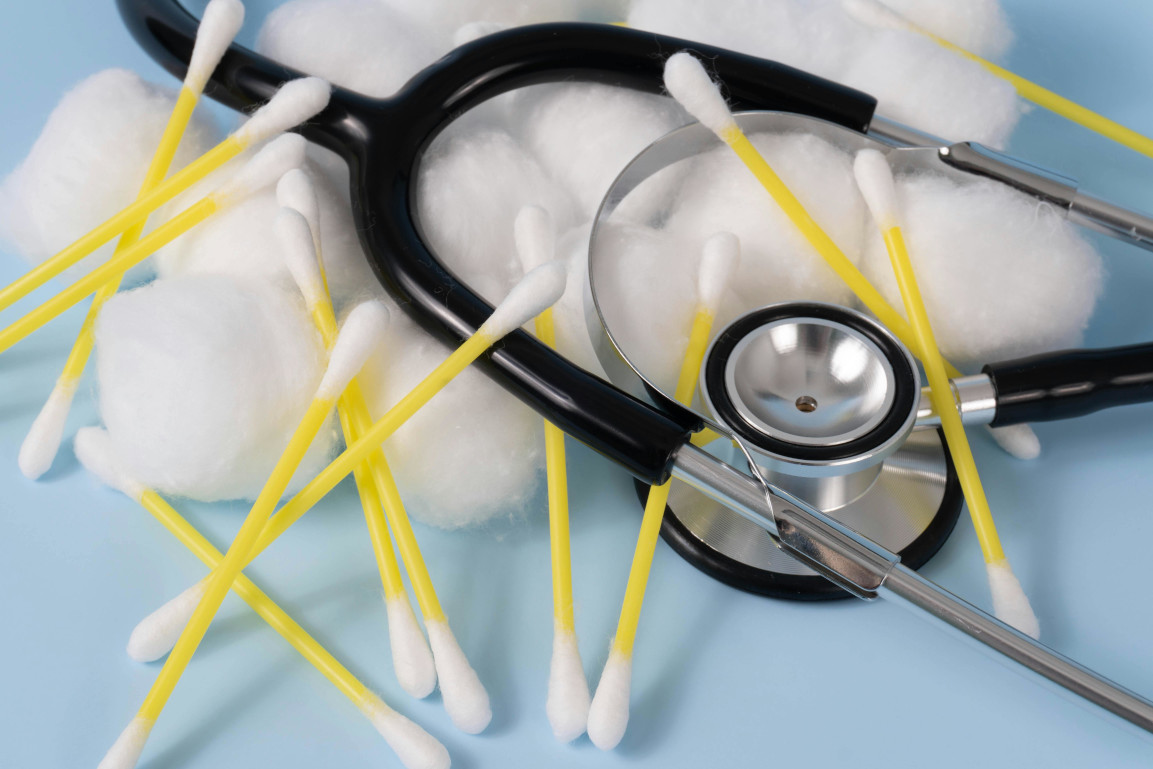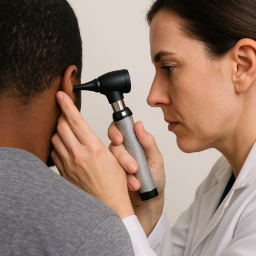Home Ear Wax Removal: When to Do It Yourself and When to See a Doctor
You may be considering home ear wax removal. Most times, you will not need to remove any ear wax. Ear wax is part of your ear’s natural self cleaning system. Specialised glands in your ear canal produce ear wax, which plays an important role in protecting your ears from harmful bacteria and fungi. Ear wax also cleans and lubricates your ear canal, trapping dust, debris, and microorganisms. In short, ear wax is generally good stuff.

Occasionally, though, ear wax may accumulate in your ear canal and you wonder what to do about it. If the ear wax accumulation is not bothering you, then it is probably best not to interfere as the ear wax will mostly clear itself. On the other hand, if the ear wax accumulation is accompanied by unpleasant symptoms such as discomfort or is causing your hearing aid or earplugs to malfunction then you will probably be thinking about removing it.
The question crossing your mind may be, “Should I try removing the ear wax at home or should I see a doctor?” This is a reasonable question as do it yourself ear wax removal is not for everyone. Here’s what you need to know.
First, check your ear canals for ear wax accumulation
It may seem obvious what is causing your ear problem. For example, you may feel like your ear is a bit blocked and it’s got to be ear wax…right? The tricky thing about ear symptoms is that the same symptom may have various causes. So, in this example, it may be ear wax causing a blocked feeling or it could be something else. If you can see ear wax accumulation in your ear canal, then the wax may be causing your symptoms. Otherwise, if you cannot see excessive wax in your ear, then the symptoms may be caused by something else and it may be better to seek medical advice earlier.
So first check for any ear wax accumulation. Either ask a friend or family member to check your ear canals for ear wax, or check yourself with a video otoscope. The ear wax accumulation may be easy to see because it is near the entrance of your ear canal. Or the ear wax accumulation may be more difficult to view because it is deeper in your ear canal.
A regular otoscope is very useful for someone else to check your ear canal, but you may want to invest in a video otoscope so that you can view inside your own ear canal. Fortunately, there are a number of video otoscope options now available that connect to your mobile phone so you can see inside your ear canal on screen. For tips on how to select and use an otoscope check out our article about viewing the ear canal. Always remember, when using an otoscope, to be careful not to push any ear wax further into your ear canal.
Decide if you should consult with your doctor
You should see a doctor and not attempt removing ear wax if you experience any of the following symptoms:
- A sudden drop in hearing or have an ongoing undiagnosed hearing loss. (A sudden hearing loss may indicate an inner ear problem and you should go straight to an emergency department.)
- Dizziness or balance issues (Your ears are part of your balance system)
- Ear pain
- Fluid or other unusual material discharging from your ear canal
- Inflamed or swollen ear canal
- Experience recurring ear infections, or have had a recent ear infection
- Ongoing ear symptoms with no ear wax accumulation.
“You should seek advice from your doctor
if you are unsure about any of your ear symptoms.”
Home ear wax removal is not recommended for children or cognitively impaired adults. You should seek medical support and advice for these vulnerable people.
Be aware of when not to put water or liquids into your ear canals
You may be wondering, why the concern about liquids in my ear canals? The concern arises because irrigating your ear canals with water and using liquids can make some ear conditions worse or lead to infections.
Removing ear wax from your ear canal at home involves irrigating your ear canals with water and/or using liquids to soften your ear wax. So you need to be aware of when it is not okay to put water and liquids into your ear canals when removing ear wax.
You should not irrigate and put liquids into your ear canals if any of the following situations apply to you (3-6). You have:
- A perforated ear drum
- Myringotomy tubes (vent tubes)
- Had ear surgery such as tympanoplasty (ear drum repair) or mastoidectomy (part of your mastoid bone removed)
- A cleft palate (even if it has been repaired)
- Unusual constrictions or growths in your ear canals that could trap moisture.
- Eczema or psoriasis or some other dermatological condition affecting your ear canals
- A foreign body in your ear canal.
- Hearing in only one ear – you do not want to damage your only good ear!
- Diabetes or have a compromised immune system
- A bleeding disorder
- Taken blood thinning medications
- Had radiotherapy of the head and neck
If any of the above situations do apply to you, then you should not attempt removing ear wax by yourself. Instead you should consult with your doctor. There are clinics that specialize in removal of ear wax. They use microscope assisted mechanical removal of ear wax that does not require water irrigation.
Be aware of the risks
Children and cognitively impaired adults should seek medical advice, while accompanied by their carer, before attempting to remove ear wax at home. Be aware of the risks involved with ear irrigation before embarking on this course of action. One survey suggested that complications occur in one ear in every 1000 ears irrigated. The most common complications included failure to remove ear wax, ear canal infection, perforated ear drum, and damage to the external ear canal (7). Other complications mentioned were pain, balance symptoms (vertigo), middle ear infection and, relatively rarely, discovery of a pre existing ear drum perforation.
When It’s Safe to Remove Ear Wax at Home
In many cases, ear wax can be managed safely at home using simple methods. Home removal may be suitable if:
You’re not experiencing pain, infection, or hearing loss
If your ears feel full or slightly blocked but you’re not in pain and there’s no discharge or significant hearing loss, you may try a home remedy.
You’ve previously had mild ear wax buildup
If you’re familiar with your ears and know they tend to get blocked occasionally, and it’s been safe to manage it in the past, self-care may be reasonable.
You use safe methods
Use only safe and gentle options such as:
- Over-the-counter ear drops to assist with softening and removing ear wax
- Warm water irrigation using equipment specifically designed and manufactured for ear irrigation such as an ear bulb – Always follow product instructions and be very gentle.
Do It Yourself Ear Wax Removal Methods to Avoid
The old wisdom still holds true – “Never put anything smaller than your elbow into your ear canal.” You may push ear wax deeper into your ear canal when using probes such as spoons and curettes. And any object that you put into your ear risks causing trauma and infection in your ear canal (8). The skin inside your ear canal is very delicate and it is easy to cause painful inflammation or cause bleeding. Remember that your ear drum is located at the end of your ear canal. If you puncture your ear drum, then this may require complex surgery to repair and leave you with a lasting hearing impairment.
“Play it safe and do not insert probes into your ear canal.”
Some popular but risky methods that should not be used to remove ear wax:
- Cotton swabs (Q-tips): These can push wax deeper, cause damage, or lead to infection.
- Ear candles: These are ineffective and can cause burns or injuries.
- Sharp objects: Never insert anything hard or pointed into your ear canal.
- Curettes and other tools: These tools are dangerous to use without professional magnification and experience.
Home Ear Wax Removal Methods Did Not Work For Me
If you’ve tried softening agents or irrigation without relief, a healthcare professional can safely remove the wax using tools like micro suction, a curette, or professional irrigation. They have access to the best techniques and equipment such as high powered professional microscopes designed for seeing deep into your ear canal.
Regular Checkups May Help You Manage Ear Wax
Some people naturally produce more ear wax or have narrow ear canals that make blockages more common. If you’re one of them, regular checkups can help prevent buildup before it becomes a problem. Or monitor your ear canals with a video otoscope.
Takeaway
While mild ear wax buildup can often be managed at home using safe methods, it’s important to know your limitations. Always seek medical advice if you are unsure about your ear symptoms or the best way to manage your ear wax. Avoid inserting objects into your ear canals, which can push wax deeper or cause ear trauma and infection. Your ears are delicate—and keeping them healthy is essential to your overall well-being. If you decide that you will remove your ear wax at home, then take a look at our post How to Safely Remove Ear Wax at Home: A Step-by-Step Guide.

